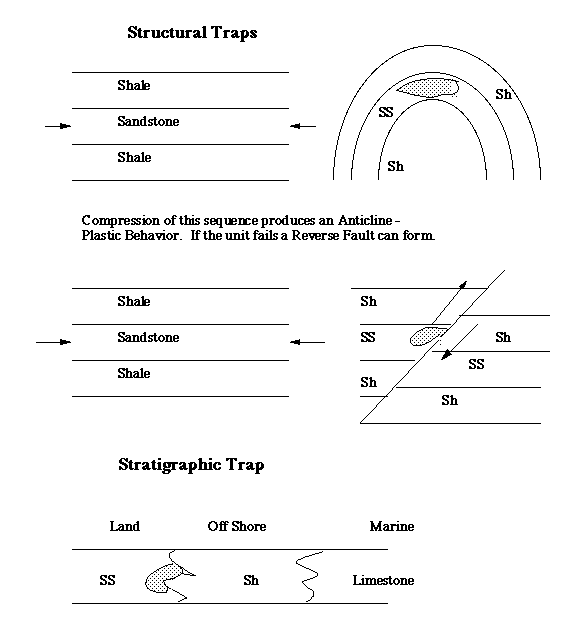Material which fails while undergoing plastic behavior fails in a _______ fashion.
brittle
ductile
spastic
In addition, review the following stress-strain plot. Remember that not all materials behave in the same way. Under a fixed stress one rock may behaving plastically, another elastically and a third may fail in a brittle fashion.

Orientation of Features
 The principal of original horizontality states that sedimentary rocks tend to be nearly flat lying (or conform to the slope of the basin they are deposited in). In mountainous regions rocks which are inclined at a large angle to the horizontal are common. In between the time of deposition and observation forces acting within the Earth have changed the orientation of this unit.
The principal of original horizontality states that sedimentary rocks tend to be nearly flat lying (or conform to the slope of the basin they are deposited in). In mountainous regions rocks which are inclined at a large angle to the horizontal are common. In between the time of deposition and observation forces acting within the Earth have changed the orientation of this unit.
When two planes intersect a line is formed. If one plane is the inclined rock layer and the other is a horizontal plane representing the surface of the Earth the direction of the line formed by their intersection is called the strike of the unit. Strike is measured with respect to true North. The dip is the maximum angle of inclination of an inclined plane and is measured perpendicular to the strike.
Think of the ground as our reference plane. Imagine moving this plane parallel to itself until it intersects the roof line. The intersection of the two planes defines the strike of the house. The roof dips in opposite directions away from the roof line. This roof is symmetrical - both sides dip an equal amount in opposite directions. What would the symbols look like from a roof that dipped more to the right than the left? What if the roof was slanted in only one direction? (a monocline).
Folds
Faults
Listric ("spoon-shaped") faults are curved faults with the concave side facing up. In order to avoid creating a huge hole in the ground, the hanging wall must deform as it moves. Locate the hanging wall and the footwall. Note that this is a Normal Fault as the hanging wall is moving down relative to the foot wall moving up. Sometimes these are called Growth Faults. Look at the following animation.
Think about Listric Faults. As material accumulates the hanging wall continues to move down relative to the footwall. Thus, the basin deepens with time. This model can explain the formation of several km of shallow water sediments in sedimentary basins. At first this seems impossible, since the sediments at the bottom of the sedimentary pile cannot form a number of kilometers below sea level and still be classified as "shallow-water." View the animation for a solution! Note that this process leads to a new type of unconformity call a progressive unconformity. There is no significant angle between ajdacent beds but the bed at the bottom of the succession is at an angle to the bed deposited at the top of the succession.
Permeability Barriers
The flow of fluids within the Earth requires the presence of connected pore spaces (measured by the permeability). Folds and faults can produce permeability barriers and trap fluids.

The Teton Mountains in Wyoming were uplifted as a result of a normal fault which is exposed at the base of the range on its eastern side. Uplift amounts to more than 7,000 feet from the Jackson Hole valley floor to the top of the Grand Teton. Much of the sculpturing is the result of Pleistocene glaciation.
Mountains
Mountains can form in a variety of ways:
- Uplifted granitic plutons
- block faulting - Basin and Range : horst and grabens - bounded by inward dipping normal faults. Grabens are the down dropped blocks and Horsts are the uplifted blocks
- Folded Mountains
- oceanic - continental plate boundaries - subduction complex
- continent - continent plate boundary
- ocean - ocean plate boundary - island arcs - may be welded onto a continental mass.
Each continent possesses at lead one or more areas of exposed ancient (Precambrian) rocks called a shield. These shields represent the stable portions of the modern continents.
_________________________________________________________________________________________________
| jbutler@uh.edu
|ClassListserv
|Textbook Home Page
|Glossary of Geologic Terms|
|Search These Pages|Other Courses|Resources|Grade Book|
_________________________________________________________________________________________________
Copyright by John C. Butler, July 29, 1995
Return